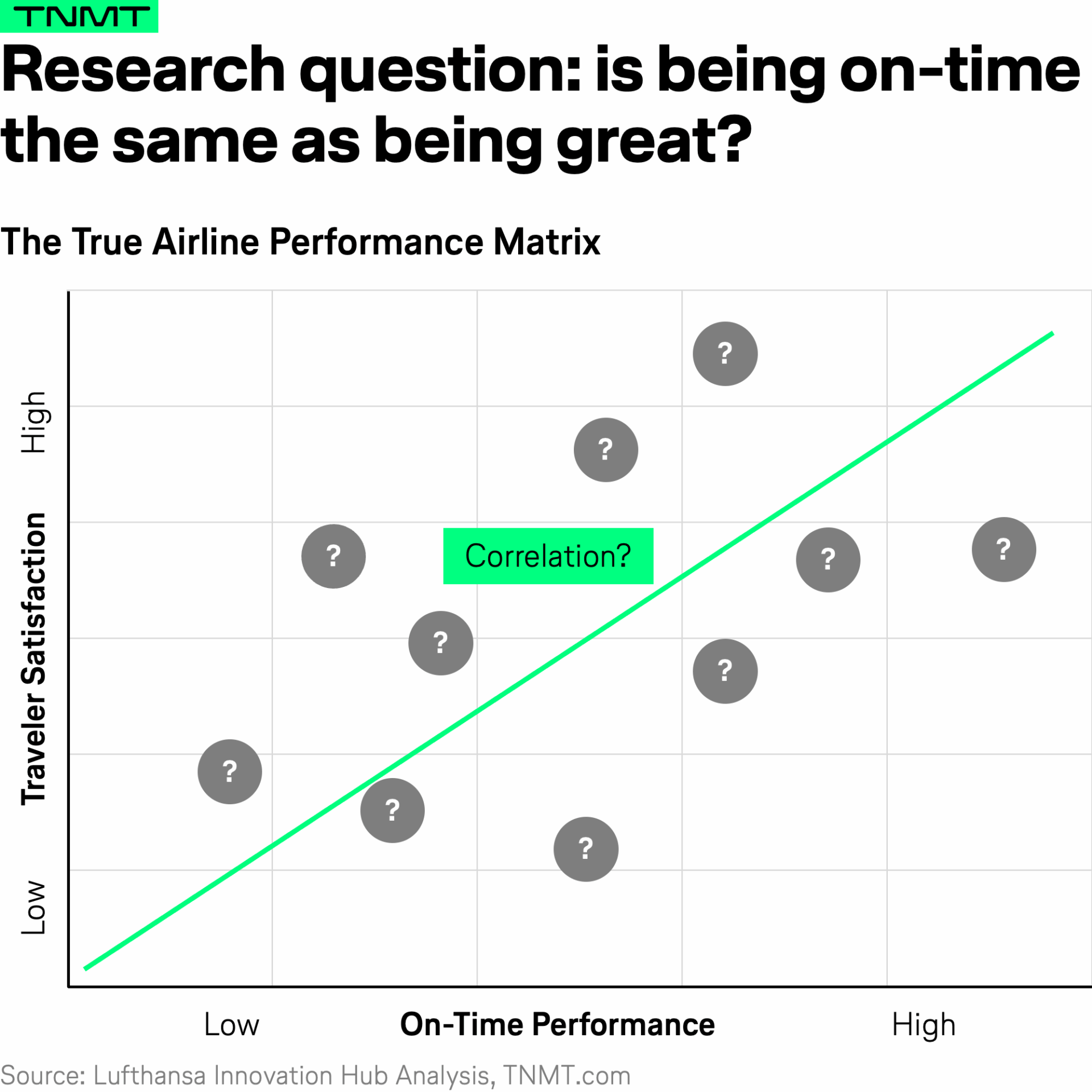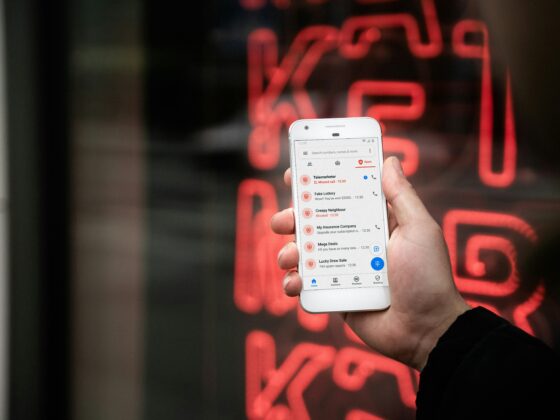On-Time Performance (OTP) is arguably the airline industry’s most worshipped KPI.
It’s not just a measure of operational efficiency.
It has been elevated to a symbol of overall quality, the supposed gold standard of what makes a “good” airline.
- Month after month, aviation media celebrate punctuality rankings as if they were league tables.
- Entire press releases are written around a single percentage point gained or lost.
- Airlines wear their OTP scores like a badge of honor.
And to be fair, the obsession makes sense.
Delays are still one of the biggest pain points in air travel.
- In the U.S. alone, 22% of all flights in 2024 were delayed, creating a ripple effect that throws off schedules for the entire day.
Our own TNMT analysis confirms that flight irregularities remain the number one frustration for travelers.
So yes, OTP matters. A lot.
But has punctuality become too much of a proxy for quality? Because if every airline is chasing the same metric, we might be missing something bigger: the actual experience of flying.
Which leads us to the real question:
Is being “on time” really the same as being great?
We wanted to find out whether the world’s most punctual airlines are truly the ones travelers love the most.
Insight #1: Testing the Obsession
In research terms, our goal was simple: test whether on-time performance actually correlates with traveler satisfaction.
If so, the industry’s OTP obsession would be justified: punctuality would indeed be the truest measure of performance. The more punctual an airline, the happier its customers – at least in theory.
But there’s one major challenge: traveler satisfaction data isn’t public or standardized.
- Most airlines do run their own Net Promoter Score (NPS) surveys, but those numbers rarely see the light of day.
- They’re kept internal, can’t be compared across carriers, and are often influenced by how the survey is framed.
In short, there’s no credible, public, industry-wide data that tells us which airlines travelers genuinely enjoy flying with.
So, we had to get creative.
In true TNMT fashion, we turned to a proxy we’ve used before: large-scale online traveler reviews.
- We aggregated more than 15,000 verified Tripadvisor reviews (all from 2024) for the five most punctual airlines in the U.S. and the five most punctual airlines in Europe (based on Cirium’s On-Time Performance Review 2024).
- To turn those reviews into data, we used Kimola, an NLP-based customer feedback analytics tool, to run sentiment analysis across every comment.
The result: for each airline, we quantified the share of positive reviews as a measurable indicator of traveler satisfaction.
Finally, we mapped that sentiment score against each airline’s on-time arrival rate in 2024.
The outcome?
- A new way to compare airline performance.
- One that goes beyond punctuality.
We call it “The True Airline Performance Matrix.”

So, without further ado, let’s look at the results.
We plotted 10 airlines (five from the U.S. and five from Europe) in our new matrix.
Sure, a truly statistical deep dive would include many more, but think of this as our proof-of-concept test: a pragmatic first pass at seeing whether punctuality really equals greatness.
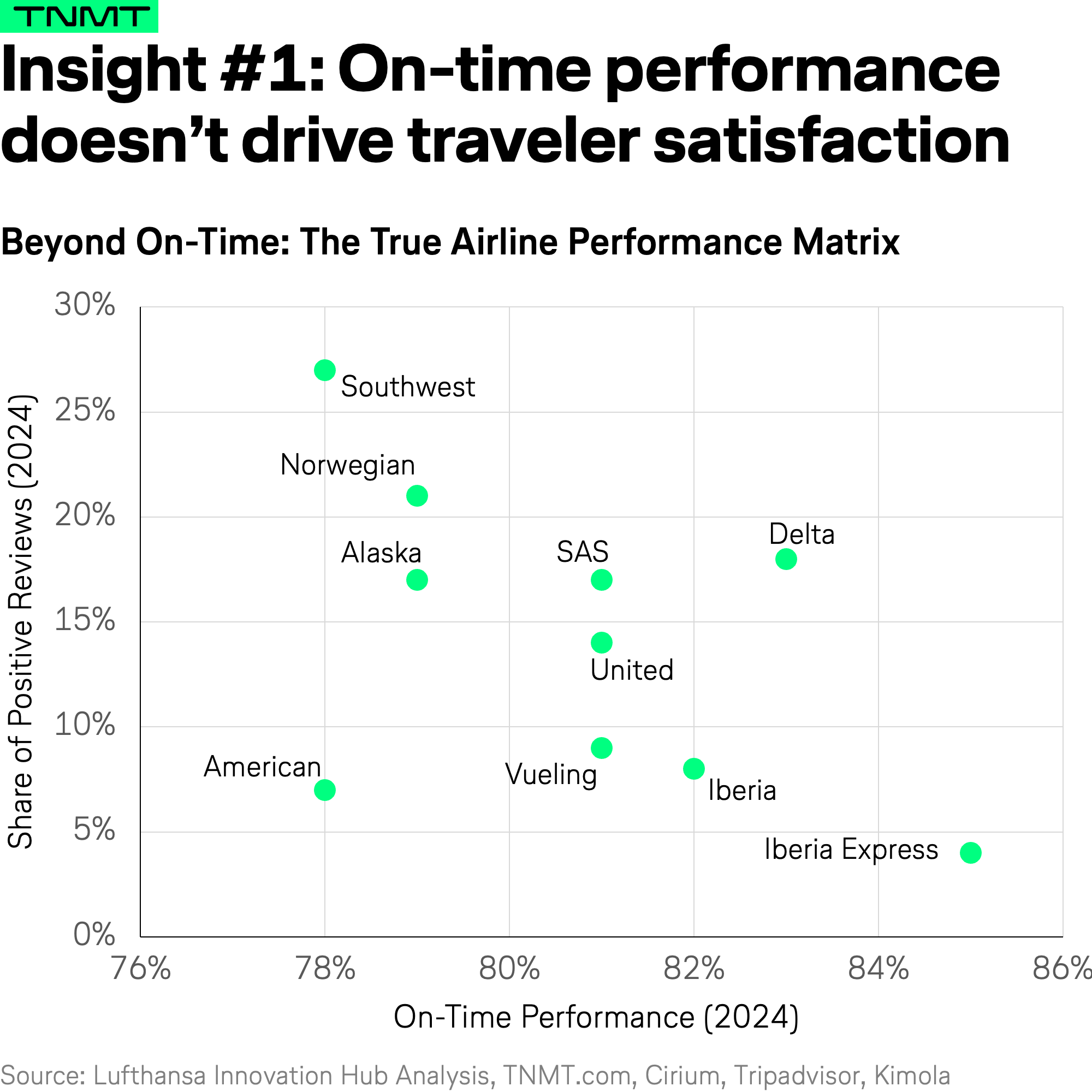
Now, do you see a neat correlation trend line showing that the more punctual an airline is, the happier its passengers are?
No?
Neither do we.
At first glance, there’s no visible correlation at all.
- Airlines are scattered across the chart with no clear pattern.
- Some carriers with modest OTP scores (around 78%) earn disproportionately positive reviews, while others boasting top punctuality rates above 80% lag behind in traveler satisfaction.
In short, being on time doesn’t necessarily mean being loved.
In fact, some airlines seem to have cracked the code on how to compensate for lower punctuality with other levers of satisfaction.
We call these airlines “The Pleasers.”
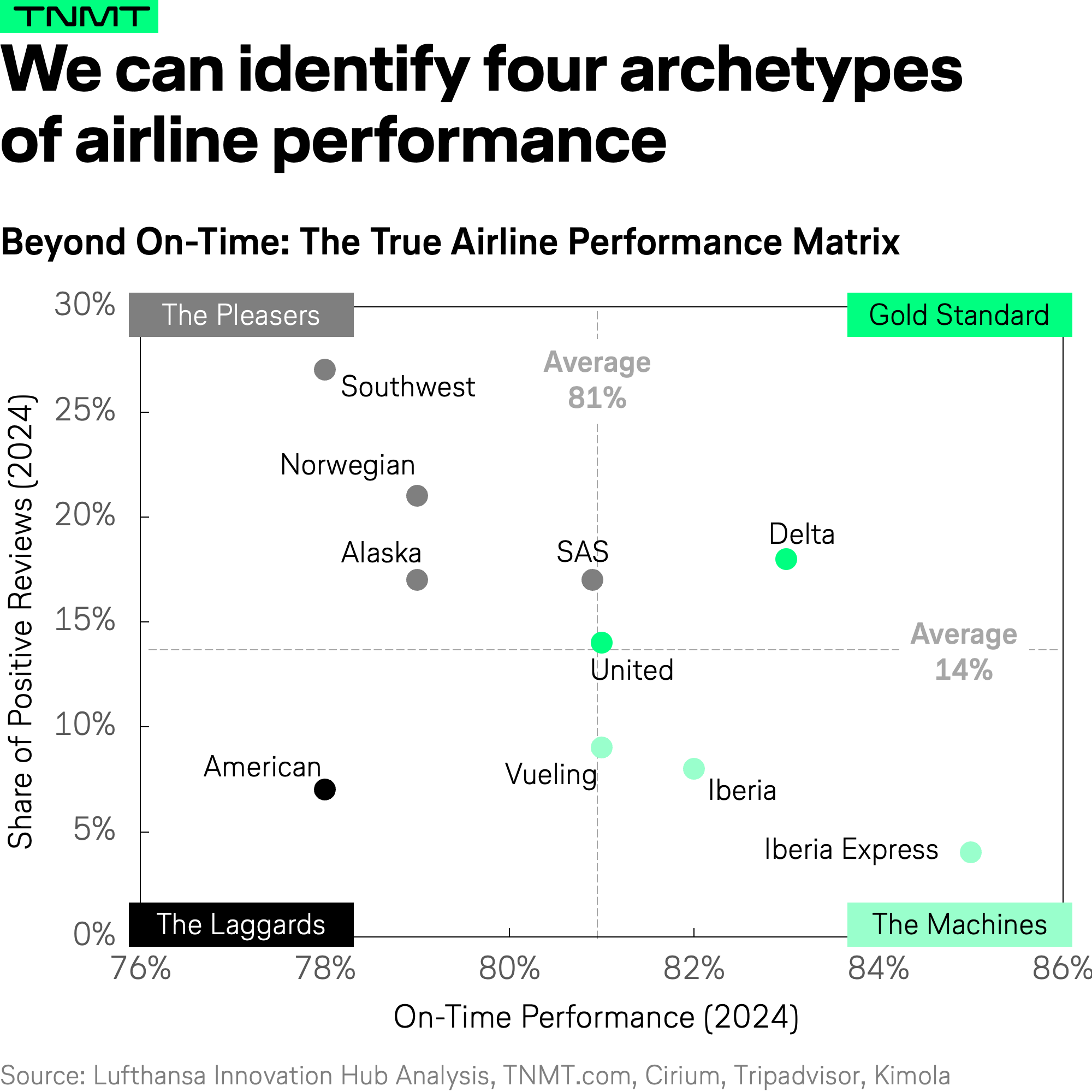
Pleasers have found a way to connect with travelers through other means, like experience, comfort, or even personality.
Take Southwest Airlines, for example.
Despite an on-time performance of “just” 78% last year, more than a quarter of all its Tripadvisor reviews are positive – the highest share amongst our airline sample.
So what’s driving these high satisfaction levels?
One hypothesis: expectations.
- As a low-cost carrier, Southwest’s passengers may be more forgiving of minor delays.
- This could also explain why Norwegian, another LCC, lands in the same “Pleaser” quadrant.
But that can’t be the whole story because Alaska Airlines and SAS also appear here, and they’re not budget carriers.
A closer look at Southwest’s reviews reveals two recurring themes travelers praise the most: comfort and crew friendliness.
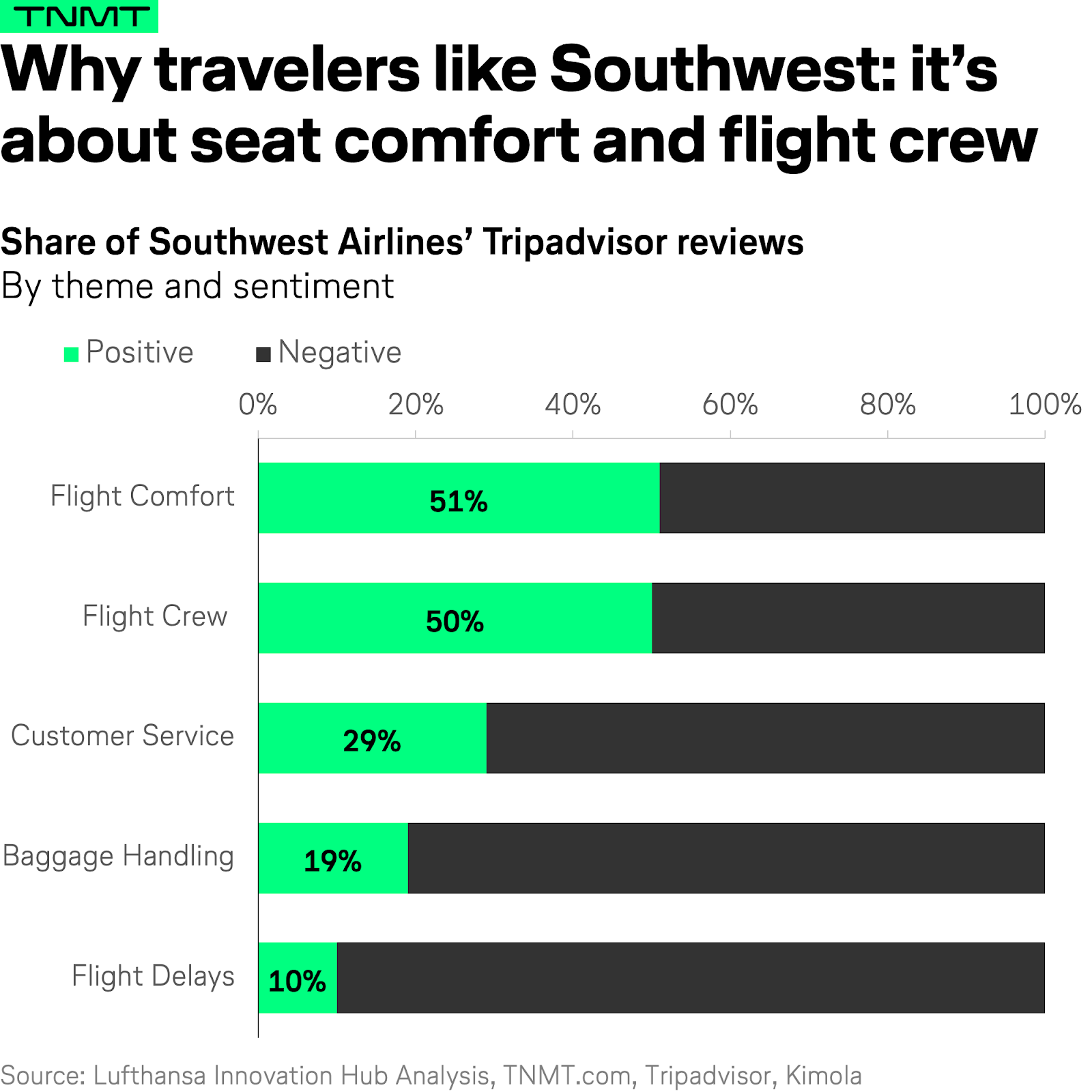
To be more exact:
- Many passengers highlight the airline’s laid-back atmosphere and approachable staff as key reasons for their positive experiences.
- Another long-standing favorite is Southwest’s open seating policy, which seems to have contributed to this perception. For decades, Southwest’s passengers boarded freely, choosing their own seats rather than following preassigned numbers. It created a sense of flexibility and even fun, which is a rare feeling in modern air travel.
Ironically, Southwest recently announced plans to end that open-seating policy and introduce paid seat selection instead. If anything, our data suggests the airline might be about to sacrifice one of its biggest differentiators – a genuine driver of traveler satisfaction.
But returning to our original research question: on-time performance alone doesn’t define quality.
“The Pleasers” prove that emotional experience can offset operational imperfection, and serve as a reminder that airlines must look beyond punctuality if they truly want to please their passengers.
But there’s more our matrix can teach us.
Insight #2: In the U.S., being on time does mean being great
But not so fast.
Maybe the relationship between punctuality and satisfaction is more nuanced than our first glance suggests. Perhaps we can’t fairly compare airlines across different regions and business models.
Because here’s an interesting twist:
When we zoom in exclusively on U.S. full-service (legacy) carriers (namely American, United, and Delta), a correlation suddenly does appear.
- American, with the lowest on-time performance, also shows the lowest share of positive reviews.
- United, sitting in the middle with an 81% OTP, collects around 15% positive reviews.
- And then there’s Delta, leading clearly on both fronts.
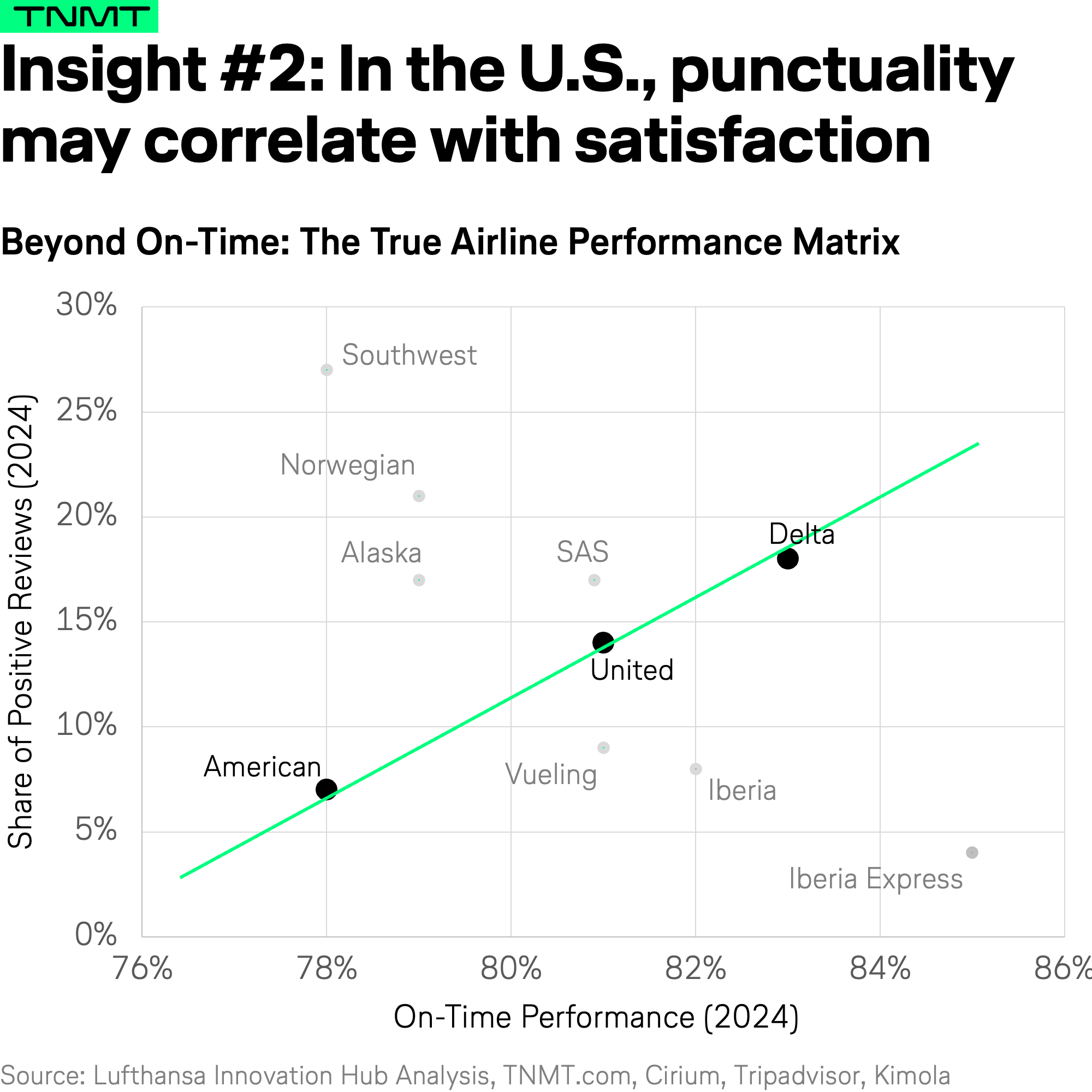
In other words, within this group, operational performance and traveler satisfaction seem closely linked.
Our assumption:
- For airlines that already share high and relatively consistent service standards, like these three legacy carriers, operational reliability becomes a true differentiator.
- When everything else feels equal (pricing, comfort, loyalty programs), being more punctual can indeed translate into higher traveler satisfaction.
This, of course, is a spontaneous synthesis, not a statistically bulletproof conclusion. Testing it properly would require a much larger dataset and a longer time horizon.
But if we were to crown any airline for its superior quality based on this analysis, our matrix would clearly say: Delta wins.
Insight #3: In Europe, efficiency comes at the expense of experience
So, Delta might be our clear winner, but before we hand out too many trophies, let’s add another layer of nuance.
When we apply the same lens to European airlines, the story flips completely.
Suddenly, a negative correlation emerges: the more punctual an airline is, the less satisfied its passengers appear to be.
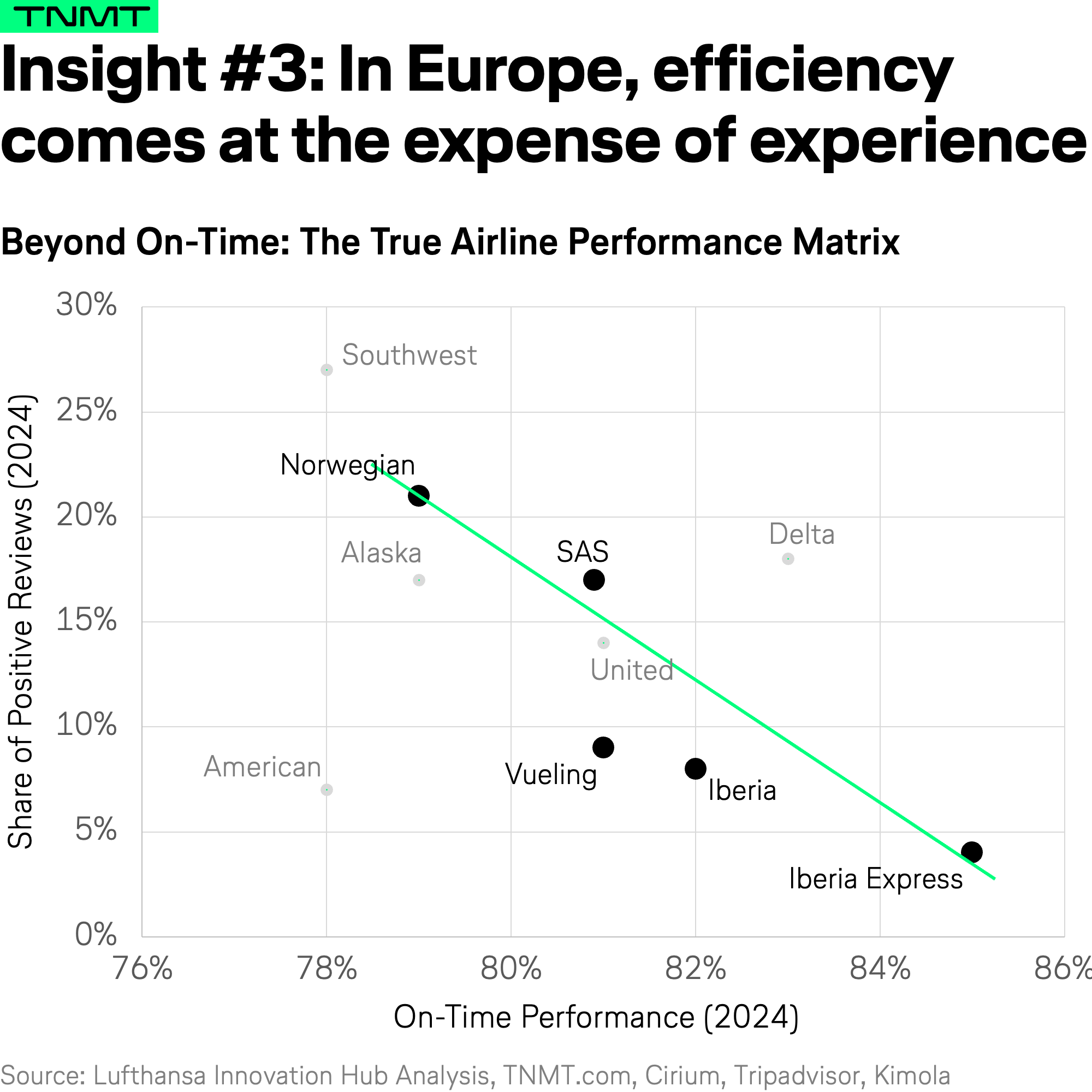
That’s right, in Europe, being more on time might actually make you less loved.
There are two possible explanations for this.
Option A: Our framework is simply too limited to draw grand conclusions. With only a dozen carriers in the sample, we might just be seeing statistical noise.
Option B: Something more structural is at play as Europe’s market dynamics differ vastly from those in the U.S.
- Many European carriers seem to optimize relentlessly for operational robustness, directing internal focus and resources toward punctuality above all else.
- But that laser focus may come at a cost: less attention to the passenger experience itself.
- Put differently: the more energy that goes into sticking to the schedule, the less remains for making travelers smile.
Which option is true?
We don’t claim to have the final answer.
This is just our first data-driven attempt at mapping what truly defines airline greatness.
If you have data, research, or experience in this area, we’d love to hear from you.
Conclusion: Before we let you go
Consider today’s analysis an imperfect exploration meant to enrich the dialogue around how airlines differentiate. Our industry is at a point where everything feels the same – the era of commoditization, as many call it. OTP may still be one way to stand out from the crowd.
So don’t get us wrong: on-time performance absolutely matters.
But it’s only one dimension of performance.
The future of airline excellence must blend operational reliability with emotional and experiential quality: what passengers feel, not just when they land.
